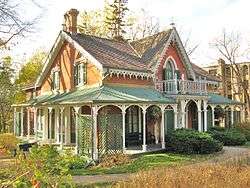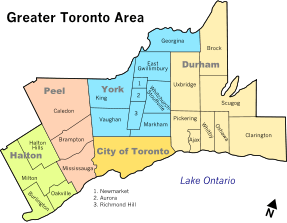Regional Municipality of York
| York Region | ||
|---|---|---|
| Regional municipality (upper-tier) | ||
| Regional Municipality of York | ||
|
The York Region Administrative Centre in Newmarket | ||
| ||
| Motto: Ontario's Rising Star | ||
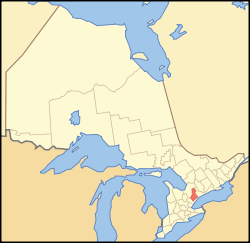 Map showing York Region's location in Ontario | ||
| Coordinates: 44°3′5″N 79°28′49″W / 44.05139°N 79.48028°WCoordinates: 44°3′5″N 79°28′49″W / 44.05139°N 79.48028°W | ||
| Country |
| |
| Province |
| |
| Established | 1792 (County) | |
| Established | 1971 (Regional Municipality) | |
| Seat | Newmarket | |
| Government | ||
| • Chair | Wayne Emmerson[1] | |
| • Governing Body | York Regional Council | |
| Area[2] | ||
| • Total | 1,762.17 km2 (680.38 sq mi) | |
| Population (2016)[2] | ||
| • Total | 1,109,909 | |
| • Density | 585.9/km2 (1,517/sq mi) | |
| Time zone | Eastern (EST) (UTC-5) | |
| • Summer (DST) | Eastern (EDT) (UTC-4) | |
| Website | www.york.ca | |
The Regional Municipality of York, also called York Region, is a regional municipality in Southern Ontario, Canada, between Lake Simcoe and Toronto. It replaced the former York County in 1971, and is part of the Greater Toronto Area and the inner ring of the Golden Horseshoe. The regional government is headquartered in Newmarket.
The 2016 census population was 1,109,909, with a growth rate of 7.5% from 2011 to 2016.[3] The Government of Ontario expects its population to surpass 1.5 million residents by 2031.[4]
History
At a meeting in Richmond Hill on 6 May 1970, officials representing the municipalities of York County approved plans for the creation of a regional government entity to replace York County.[5] The plan had been presented in 1969 by Darcy McKeough, the Ontario Minister of Municipal Affairs, taking about a year to determine municipal boundaries within the new regional government.[5]
The Regional Municipality of York was created by Act of the Legislative Assembly of Ontario in 1970, which took effect on January 1, 1971.[6] The creation of the regional municipality resulted in the consolidation of the fourteen former municipalities of York County into nine new municipalities:[7]
| Area municipality | Created from | Police villages dissolved |
|---|---|---|
| Town of Aurora | Town of Aurora, annexing portions of the Townships of King and Whitchurch | |
| Town of East Gwillimbury | Portion of the Township of East Gwillimbury | |
| Town of Georgina | Townships of Georgina and North Gwillimbury, and the Village of Sutton | |
| Township of King | Portion of the Township of King | |
| City of Markham | Town of Markham, annexing portion of the Township of Markham |
|
| Town of Newmarket | Town of Newmarket, annexing portions of the Townships of East Gwillimbury, King and Whitchurch | |
| Town of Richmond Hill | Town of Richmond Hill, annexing portions of the Townships of King, Markham, Vaughan and Whitchurch | |
| City of Vaughan | Village of Woodbridge, annexing portions of the Townships of King and Vaughan |
|
| Town of Whitchurch–Stouffville | Village of Stouffville, annexing portions of the Townships of Markham and Whitchurch |
The township of Whitchurch was merged with the town of Stouffville to create the town of Whitchurch–Stouffville, ceding land to Aurora, Newmarket, and Richmond Hill to the west of the proposed Highway 404 and annexing a northern strip of land from the township of Markham.[9] The eastern boundary of the new town of Markham was defined to be at Yonge Street, where its northern boundary was formed with Richmond Hill (to which it ceded some land[5]) and its western boundary with the new town Vaughan.[9] The new town of Vaughan would consist of all communities in the area bounded by Markham and Richmond Hill in the east, Metro Toronto in the south, the periphery of the regional municipality in the west, and the new township of King in the north.[9] The townships of Georgina, North Gwillimbury, and Sutton were merged into the township of Georgina, and the East Gwillimbury neighbourhood of East Gwillimbury Heights was merged into Newmarket.[9] King formed the northwestern part of the new region, but the eastern lot from Bathurst Street to Yonge Street was ceded to Newmarket, Aurora, and Oak Ridges, the latter of which became a part of Richmond Hill.[9] The boundary between Aurora and Newmarket was defined to be St. John's Sideroad, and Newmarket's northern boundary was defined to be Green Lane.[9]
The towns of Aurora, Newmarket, and Richmond Hill were defined to be the growth centres for the regional municipality, which was to become a greenbelt between the denser urban areas of Toronto to the south and Barrie to the north.[7] The growth centres were each restricted to grow to a maximum population of 25,000 by 2000,[7] and the regional municipality to 300,000.[9]
The municipal realignment merged 40% of East Gwillimbury's population into Newmarket.[10] The council of East Gwillimbury voted to amalgamate with Newmarket, but Newmarket council opposed the amalgamation.[10] In the plan presented by McKeough, the councils of the towns of Newmarket and Aurora were given ten years to decide whether or not to amalgamate.[7]
The internal municipal realignments resulted in some politicians residing in a new municipality from that which they represented at the time of realignment.[5] The reeve of Whitchurch Township resided in the western portion of the town that was annexed by Aurora, three East Gwillimbury councillors resided in land annexed by Newmarket, including its future mayor Ray Twinney, and King councillor Gordon Rowe was a resident of Oak Ridges, which became part of Richmond Hill.[5]
Hydro Commissions
Because of the mix of urban and rural areas in the Region, the provision of electricity was governed in a different manner from the rest of the regional services:[11]
- the hydro-electric commissions and public utilities commissions that existed at the end of 1970 continued to provide electricity within their respective areas;
- the councillors of the former Township of Vaughan and the trustees of the former Police Village of King City became members of new Hydro-Electric Commissions for their respective areas;
- Ontario Hydro continued to have responsibility for providing electricity to those portions of the Region that were not served by any of the above commissions.
Electric distribution was partially rationalized in 1978,[12] when:
- hydro-electric commissions were established for all area municipalities except East Gwillimbury[13] (but the latter could establish a commission later on, subject to Ontario Hydro's consent);[14]
- effective January 1, 1979, all assets of the former commissions in the Region were transferred to the new commissions;[15]
- Ontario Hydro withdrew its provision of services from all areas except those in East Gwillimbury, Georgina, King and Whitchurch-Stouffville;[15]
- Georgina, King and Whitchurch-Stouffville could take over responsibility for such areas at a later date, subject to Ontario Hydro's consent[15]
Police
The York Regional Police was also created at this time, amalgamating the fourteen town, township, and village police forces.[5]
Geography
York Region covers 1,762 square kilometres from Lake Simcoe in the north to the city of Toronto in the south. Its eastern border is shared with Durham Region, to the west is Peel Region, and Simcoe County is to the northwest. A detailed map of the region[16] showing its major roads, communities and points of interest is available.

Towns and cities in York Region include:
- Town of Aurora
- Town of East Gwillimbury
- Town of Georgina
- Township of King
- City of Markham
- Town of Newmarket
- Town of Richmond Hill
- City of Vaughan
- Town of Whitchurch–Stouffville
There is also one First Nation with an Indian reserve, where the Chippewas of Georgina Island First Nation reside on Georgina Island, Fox Island and Snake Island.
York Region's landscape includes farmlands, wetlands and kettle lakes, the Oak Ridges Moraine and over 2,070 hectares of regional forest, in addition to the built-up areas of its municipalities.
Climate
York Region is situated on a humid continental climate (Köppen Dfb) with warm summers and cold winters.
| Climate data for Markham 1981–2010 (Toronto/Buttonville Municipal Airport) | |||||||||||||
|---|---|---|---|---|---|---|---|---|---|---|---|---|---|
| Month | Jan | Feb | Mar | Apr | May | Jun | Jul | Aug | Sep | Oct | Nov | Dec | Year |
| Record high humidex | 16.0 | 14.4 | 29.2 | 35.7 | 41.0 | 44.6 | 50.9 | 47.4 | 43.6 | 37.8 | 24.9 | 20.6 | 50.9 |
| Record high °C (°F) | 14.9 (58.8) |
14.9 (58.8) |
26.0 (78.8) |
31.7 (89.1) |
34.6 (94.3) |
36.6 (97.9) |
37.2 (99) |
37.8 (100) |
34.4 (93.9) |
31.0 (87.8) |
22.1 (71.8) |
18.0 (64.4) |
37.8 (100) |
| Average high °C (°F) | −1.5 (29.3) |
−0.9 (30.4) |
4.5 (40.1) |
12.1 (53.8) |
19.1 (66.4) |
24.6 (76.3) |
27.1 (80.8) |
26.0 (78.8) |
21.5 (70.7) |
14.1 (57.4) |
7.2 (45) |
0.9 (33.6) |
12.9 (55.2) |
| Daily mean °C (°F) | −5.8 (21.6) |
−5.6 (21.9) |
−0.4 (31.3) |
6.7 (44.1) |
13.0 (55.4) |
18.6 (65.5) |
21.2 (70.2) |
20.2 (68.4) |
15.7 (60.3) |
8.9 (48) |
3.1 (37.6) |
−2.9 (26.8) |
7.7 (45.9) |
| Average low °C (°F) | −10.1 (13.8) |
−10.2 (13.6) |
−5.3 (22.5) |
1.2 (34.2) |
6.8 (44.2) |
12.6 (54.7) |
15.2 (59.4) |
14.3 (57.7) |
9.9 (49.8) |
3.6 (38.5) |
−1.1 (30) |
−6.8 (19.8) |
2.5 (36.5) |
| Record low °C (°F) | −35.2 (−31.4) |
−25.7 (−14.3) |
−25.6 (−14.1) |
−10.1 (13.8) |
−2.1 (28.2) |
1.9 (35.4) |
6.9 (44.4) |
4.2 (39.6) |
−2.0 (28.4) |
−7.4 (18.7) |
−15.0 (5) |
−26.0 (−14.8) |
−35.2 (−31.4) |
| Record low wind chill | −42.6 | −37.4 | −35.6 | −18.6 | −4.4 | 0.0 | 0.0 | 0.0 | −4.2 | −8.8 | −23.9 | −36.6 | −42.6 |
| Average precipitation mm (inches) | 62.1 (2.445) |
50.5 (1.988) |
53.2 (2.094) |
74.1 (2.917) |
79.6 (3.134) |
82.8 (3.26) |
79.0 (3.11) |
76.2 (3) |
81.8 (3.22) |
68.0 (2.677) |
80.0 (3.15) |
65.7 (2.587) |
852.9 (33.579) |
| Average rainfall mm (inches) | 26.0 (1.024) |
22.9 (0.902) |
33.6 (1.323) |
66.7 (2.626) |
79.5 (3.13) |
82.8 (3.26) |
78.8 (3.102) |
76.2 (3) |
81.8 (3.22) |
66.7 (2.626) |
68.3 (2.689) |
34.2 (1.346) |
717.4 (28.244) |
| Average snowfall cm (inches) | 38.9 (15.31) |
29.9 (11.77) |
19.3 (7.6) |
7.5 (2.95) |
0.1 (0.04) |
0.0 (0) |
0.0 (0) |
0.0 (0) |
0.0 (0) |
0.6 (0.24) |
12.1 (4.76) |
34.2 (13.46) |
142.6 (56.14) |
| Average precipitation days (≥ 0.2 mm) | 16.7 | 12.9 | 12.0 | 12.3 | 12.0 | 11.8 | 11.2 | 9.9 | 10.8 | 13.2 | 14.5 | 15.3 | 152.7 |
| Average rainy days (≥ 0.2 mm) | 5.8 | 3.8 | 6.7 | 10.8 | 12.0 | 11.8 | 11.2 | 9.9 | 10.8 | 13.0 | 11.3 | 6.6 | 113.7 |
| Average snowy days (≥ 0.2 cm) | 13.4 | 10.8 | 7.0 | 2.9 | 0.13 | 0.0 | 0.0 | 0.0 | 0.0 | 0.48 | 4.7 | 10.8 | 50.2 |
| Average relative humidity (%) (at 1500 LST) | 69.6 | 64.0 | 57.8 | 52.9 | 52.3 | 53.9 | 53.4 | 55.9 | 59.2 | 62.4 | 68.9 | 71.1 | 60.1 |
| Source: Environment Canada[17] | |||||||||||||
| Climate data for Richmond Hill (1981−2010) | |||||||||||||
|---|---|---|---|---|---|---|---|---|---|---|---|---|---|
| Month | Jan | Feb | Mar | Apr | May | Jun | Jul | Aug | Sep | Oct | Nov | Dec | Year |
| Record high °C (°F) | 14.5 (58.1) |
14.5 (58.1) |
25.5 (77.9) |
31.0 (87.8) |
34.5 (94.1) |
35.0 (95) |
37.0 (98.6) |
37.0 (98.6) |
34.4 (93.9) |
29.4 (84.9) |
23.3 (73.9) |
20.0 (68) |
37.0 (98.6) |
| Average high °C (°F) | −2.2 (28) |
−0.6 (30.9) |
4.4 (39.9) |
12.1 (53.8) |
19.0 (66.2) |
24.2 (75.6) |
26.8 (80.2) |
25.6 (78.1) |
20.9 (69.6) |
13.7 (56.7) |
6.7 (44.1) |
0.8 (33.4) |
12.6 (54.7) |
| Daily mean °C (°F) | −6.2 (20.8) |
−4.9 (23.2) |
−0.3 (31.5) |
6.9 (44.4) |
13.3 (55.9) |
18.7 (65.7) |
21.4 (70.5) |
20.3 (68.5) |
15.9 (60.6) |
9.1 (48.4) |
3.1 (37.6) |
−2.7 (27.1) |
7.9 (46.2) |
| Average low °C (°F) | −10.2 (13.6) |
−9.1 (15.6) |
−5 (23) |
1.7 (35.1) |
7.7 (45.9) |
13.1 (55.6) |
15.9 (60.6) |
15.1 (59.2) |
10.8 (51.4) |
4.5 (40.1) |
−0.5 (31.1) |
−6.1 (21) |
3.2 (37.8) |
| Record low °C (°F) | −32.5 (−26.5) |
−29 (−20) |
−27 (−17) |
−15 (5) |
−5.6 (21.9) |
0.6 (33.1) |
4.4 (39.9) |
3.0 (37.4) |
−3.3 (26.1) |
−7.8 (18) |
−15.5 (4.1) |
−30 (−22) |
−32.5 (−26.5) |
| Average precipitation mm (inches) | 62.3 (2.453) |
58.0 (2.283) |
58.8 (2.315) |
70.1 (2.76) |
81.6 (3.213) |
80.2 (3.157) |
83.5 (3.287) |
89.2 (3.512) |
88.4 (3.48) |
69.1 (2.72) |
87.2 (3.433) |
66.8 (2.63) |
895.2 (35.244) |
| Average rainfall mm (inches) | 25.2 (0.992) |
26.3 (1.035) |
33.6 (1.323) |
62.5 (2.461) |
81.5 (3.209) |
80.2 (3.157) |
83.5 (3.287) |
89.2 (3.512) |
88.4 (3.48) |
67.6 (2.661) |
73.5 (2.894) |
33.1 (1.303) |
744.6 (29.315) |
| Average snowfall cm (inches) | 37.1 (14.61) |
31.7 (12.48) |
25.2 (9.92) |
7.6 (2.99) |
0.1 (0.04) |
0.0 (0) |
0.0 (0) |
0.0 (0) |
0.0 (0) |
1.5 (0.59) |
13.7 (5.39) |
33.7 (13.27) |
150.6 (59.29) |
| Average precipitation days (≥ 0.2 mm) | 18.3 | 13.9 | 14.4 | 13.6 | 13.6 | 11.9 | 11.3 | 11.2 | 12.4 | 13.4 | 15.2 | 16.2 | 165.2 |
| Average rainy days (≥ 0.2 mm) | 4.9 | 4.3 | 7.4 | 11.7 | 13.6 | 11.9 | 11.3 | 11.2 | 12.4 | 13.3 | 11.4 | 7.0 | 120.2 |
| Average snowy days (≥ 0.2 cm) | 15.3 | 11.3 | 9.0 | 3.2 | 0.12 | 0.0 | 0.0 | 0.0 | 0.0 | 0.62 | 5.3 | 11.6 | 56.5 |
| Source: Environment Canada[18] | |||||||||||||
| Climate data for Stouffville 1971–2000 | |||||||||||||
|---|---|---|---|---|---|---|---|---|---|---|---|---|---|
| Month | Jan | Feb | Mar | Apr | May | Jun | Jul | Aug | Sep | Oct | Nov | Dec | Year |
| Record high °C (°F) | 11.0 (51.8) |
13.5 (56.3) |
23.0 (73.4) |
30.5 (86.9) |
32.0 (89.6) |
34.0 (93.2) |
35.5 (95.9) |
36.5 (97.7) |
32.8 (91) |
25.5 (77.9) |
22.8 (73) |
18.0 (64.4) |
36.5 (97.7) |
| Average high °C (°F) | −3.2 (26.2) |
−2.4 (27.7) |
3.1 (37.6) |
11.1 (52) |
18.5 (65.3) |
23.1 (73.6) |
26.2 (79.2) |
24.7 (76.5) |
19.9 (67.8) |
12.8 (55) |
6.0 (42.8) |
−0.6 (30.9) |
11.6 (52.9) |
| Average low °C (°F) | −11.6 (11.1) |
−10.9 (12.4) |
−5.7 (21.7) |
1.2 (34.2) |
7.4 (45.3) |
11.8 (53.2) |
14.8 (58.6) |
14 (57) |
9.6 (49.3) |
3.5 (38.3) |
−1.0 (30.2) |
−7.7 (18.1) |
2.1 (35.8) |
| Record low °C (°F) | −35.5 (−31.9) |
−28.3 (−18.9) |
−28.0 (−18.4) |
−17.0 (1.4) |
−3.3 (26.1) |
0.0 (32) |
7.0 (44.6) |
2.5 (36.5) |
−2.0 (28.4) |
−7.2 (19) |
−15.0 (5) |
−31.5 (−24.7) |
−35.5 (−31.9) |
| Average precipitation mm (inches) | 52.8 (2.079) |
53.5 (2.106) |
62.8 (2.472) |
65.5 (2.579) |
81.2 (3.197) |
73.3 (2.886) |
75.8 (2.984) |
99.3 (3.909) |
79.2 (3.118) |
81.2 (3.197) |
78.5 (3.091) |
65.6 (2.583) |
868.6 (34.197) |
| Average rainfall mm (inches) | 17.9 (0.705) |
23.3 (0.917) |
43.5 (1.713) |
60.5 (2.382) |
81.1 (3.193) |
73.3 (2.886) |
75.8 (2.984) |
99.3 (3.909) |
79.2 (3.118) |
80.6 (3.173) |
70.3 (2.768) |
33.0 (1.299) |
737.7 (29.043) |
| Average snowfall cm (inches) | 34.9 (13.74) |
30.2 (11.89) |
19.3 (7.6) |
5.0 (1.97) |
0.1 (0.04) |
0.0 (0) |
0.0 (0) |
0.0 (0) |
0.0 (0) |
0.6 (0.24) |
8.2 (3.23) |
32.7 (12.87) |
131.0 (51.57) |
| Average precipitation days (≥ 0.2 mm) | 11.0 | 10.3 | 10.1 | 10.8 | 11.0 | 10.7 | 9.2 | 10.8 | 10.4 | 13.0 | 12.6 | 12.3 | 131.9 |
| Average rainy days (≥ 0.2 mm) | 2.9 | 3.1 | 6.2 | 9.8 | 11.0 | 10.7 | 9.2 | 10.8 | 10.4 | 13.0 | 10.7 | 5.1 | 102.6 |
| Average snowy days (≥ 0.2 cm) | 8.4 | 7.7 | 4.7 | 1.2 | 0.1 | 0.0 | 0.0 | 0.0 | 0.0 | 0.2 | 2.6 | 8.3 | 33.1 |
| Source: Environment Canada[19] | |||||||||||||
| Climate data for Vaughan 1981–2010 (Woodbridge) | |||||||||||||
|---|---|---|---|---|---|---|---|---|---|---|---|---|---|
| Month | Jan | Feb | Mar | Apr | May | Jun | Jul | Aug | Sep | Oct | Nov | Dec | Year |
| Record high °C (°F) | 17.0 (62.6) |
15.5 (59.9) |
26.5 (79.7) |
31.5 (88.7) |
33.0 (91.4) |
36.0 (96.8) |
39.0 (102.2) |
37.2 (99) |
36.1 (97) |
30.6 (87.1) |
25.0 (77) |
19.5 (67.1) |
39.0 (102.2) |
| Average high °C (°F) | −2.5 (27.5) |
−0.5 (31.1) |
4.3 (39.7) |
12.0 (53.6) |
18.8 (65.8) |
24.1 (75.4) |
26.9 (80.4) |
25.4 (77.7) |
20.9 (69.6) |
13.9 (57) |
6.9 (44.4) |
0.8 (33.4) |
12.6 (54.7) |
| Daily mean °C (°F) | −6.6 (20.1) |
−4.8 (23.4) |
−0.4 (31.3) |
6.6 (43.9) |
12.9 (55.2) |
18.1 (64.6) |
20.8 (69.4) |
19.6 (67.3) |
15.4 (59.7) |
9.0 (48.2) |
3.1 (37.6) |
−2.8 (27) |
7.6 (45.7) |
| Average low °C (°F) | −10.7 (12.7) |
−9.2 (15.4) |
−5.2 (22.6) |
1.2 (34.2) |
6.8 (44.2) |
12.0 (53.6) |
14.7 (58.5) |
13.8 (56.8) |
9.8 (49.6) |
4.0 (39.2) |
−0.8 (30.6) |
−6.4 (20.5) |
2.5 (36.5) |
| Record low °C (°F) | −34.5 (−30.1) |
−30.0 (−22) |
−29.4 (−20.9) |
−17.2 (1) |
−6.7 (19.9) |
−1.7 (28.9) |
2.8 (37) |
−0.6 (30.9) |
−5.0 (23) |
−11.7 (10.9) |
−18.3 (−0.9) |
−30.0 (−22) |
−34.5 (−30.1) |
| Average precipitation mm (inches) | 50.3 (1.98) |
44.2 (1.74) |
49.2 (1.937) |
63.3 (2.492) |
79.1 (3.114) |
76.3 (3.004) |
70.4 (2.772) |
80.4 (3.165) |
84.6 (3.331) |
66.5 (2.618) |
78.3 (3.083) |
57.4 (2.26) |
799.8 (31.488) |
| Average rainfall mm (inches) | 20.4 (0.803) |
23.2 (0.913) |
31.4 (1.236) |
59.6 (2.346) |
79.1 (3.114) |
76.3 (3.004) |
70.4 (2.772) |
80.4 (3.165) |
84.6 (3.331) |
66.0 (2.598) |
71.1 (2.799) |
34.6 (1.362) |
697.0 (27.441) |
| Average snowfall cm (inches) | 29.9 (11.77) |
21.1 (8.31) |
17.8 (7.01) |
3.7 (1.46) |
0.0 (0) |
0.0 (0) |
0.0 (0) |
0.0 (0) |
0.0 (0) |
0.45 (0.177) |
7.2 (2.83) |
22.8 (8.98) |
102.8 (40.47) |
| Average precipitation days (≥ 0.2 mm) | 13.5 | 10.3 | 10.7 | 11.8 | 12.0 | 10.8 | 9.5 | 9.6 | 10.6 | 12.7 | 13.1 | 12.8 | 137.4 |
| Average rainy days (≥ 0.2 mm) | 4.2 | 4.4 | 6.4 | 10.7 | 12.0 | 10.8 | 9.5 | 9.6 | 10.6 | 12.6 | 11.1 | 6.5 | 108.3 |
| Average snowy days (≥ 0.2 cm) | 10.2 | 6.8 | 5.1 | 1.5 | 0.0 | 0.0 | 0.0 | 0.0 | 0.0 | 0.23 | 3.0 | 7.5 | 34.3 |
| Source: Environment Canada[20] | |||||||||||||
Government
The region is governed by a group known as York Regional Council, which consists of 20 elected representatives from each of the constituent towns and cities in the region. These include each of the nine mayors, and 11 regional councillors who are elected from the constituent municipalities as follows:[21]
- 1 from Georgina
- 1 from Newmarket
- 2 from Richmond Hill
- 3 from Vaughan
- 4 from Markham
The leader of Council is referred to as "Regional Chair and CEO". Wayne Emmerson, a former mayor of Whitchurch-Stouffville, was elected to this office in December, 2014.
In October 2008, the York Regional Municipality was named one of Greater Toronto's Top Employers by Mediacorp Canada Inc.[22]
Federal and provincial representation
Starting with the 2015 federal election, York Region encompasses all or part of the federal electoral districts of Aurora—Oak Ridges—Richmond Hill, King—Vaughan, Markham—Stouffville, Markham—Thornhill, Markham—Unionville, Newmarket—Aurora, Richmond Hill, Thornhill, Vaughan—Woodbridge, and York—Simcoe.
Provincially, York Region is represented in the Legislative Assembly of Ontario by Members of Provincial Parliament for the electoral districts of Markham—Unionville, Newmarket—Aurora, Oak Ridges—Markham, Richmond Hill, Thornhill, Vaughan and York—Simcoe.
Economy
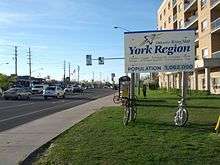
The economy of York Region is diverse. In general, the economy includes a full range of businesses from industrial to high-tech to rural / agricultural. New developments continually consume space year after and are especially focused along the Yonge Street corridor from Vaughan/Richmond Hill in the south to Newmarket/Aurora in the north. There are ongoing conflicts between conservationists and developers over land use. Most contentious is the conflict use of the Oak Ridges Moraine.
Shopping
Major shopping centres located in York Region include:
- Aurora North Smart Centre (Aurora)
- Hillcrest Mall (Richmond Hill)
- Green Lane Centre (Newmarket)
- King Square Shopping Mall (Markham)
- Markville Shopping Centre (Markham)
- Pacific Mall (Markham)
- Market Village (Markham)
- The Promenade Shopping Centre (Vaughan)
- Times Square (Richmond Hill)
- Langham Square (Markham)
- Upper Canada Mall (Newmarket)
- Woodside Mall (Markham)
- Vaughan Mills (Vaughan)
- First Markham Place (Markham)
Health Care
There are currently three hospitals within the Municipality of York including:
All three hospitals are part of the Local Health Integration Network (LHIN) Hospital Partnerships.
In 2011 the construction of Mackenzie Vaughan Hospital was approved by the Minister of Health and Long-Term Care, Deb Matthews. The hospital site is proposed within the City of Vaughan at Major Mackenzie Drive on the east side of Highway 400. Current plans include a new $80 million building.
In April 2013, Counselling Services for York Region opened Ontario's first Cognitive Behavioural Therapy Clinic. The clinic specializes in offering a specialized empirically supported form of individual and group therapy.
Transportation
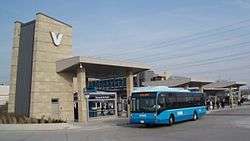
The arterial road network in York Region is a grid, with most roads running north-south or east-west. This was done under the orders of British surveyor Augustus Jones during the 1790s. York Region assigned approximately 50 roads as York Regional Routes, meaning that the cost of maintaining of these roads is paid for by York Region.
The major highways in the Region are:
- Highway 7 (east-west)
- Highway 9 (east-west)
- Highway 48 (north-south)
- Highway 400 (north-south)
- Highway 404 (north-south)
- Highway 407 (east-west)
- Highway 427 (north-south)
Former highways include:
- Highway 11 (north-south)
- Highway 27 (north-south)
- Highway 47 (east-west)
- Highway 49 (east-west)
- Highway 50 (north-south)
- Note: Highway 27 and Highway 50 are still referred to as such on municipal road signs, but are no longer provincial highways.
Air transportation
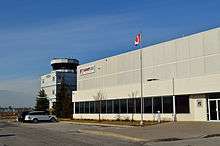
Most air travel is served by Toronto Pearson International Airport, Canada's largest airport. Buttonville Municipal Airport is a regional airport in Markham, used for general aviation and business aircraft. There are also a few unpaved airports serving the region. Hare Field is located in Holland Landing (East Gwillimbury) and Belhaven Airport is located in Georgina.
Public transportation
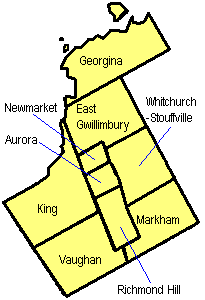
York Region is served by:
- York Region Transit (YRT), which includes the Viva bus rapid transit network
- GO Transit, which offers bus and train service
- Toronto Transit Commission (TTC), which has several bus routes which cross York's southern border, and which offer limited services in Vaughan, Richmond Hill and Markham. Starting in 2017, Vaughan will also be served by Toronto's subway system, as well as Richmond Hill and Markham in the coming decade.
Until 2001, the towns of York Region operated separate public transit services, which did not connect very well with each other. YRT was created by the Regional Government to combine five of these services:
- Vaughan Transit
- Markham Transit
- Richmond Hill Transit
- Aurora Transit - merged in 1999 with Newmarket Transit
- Newmarket Transit
Since 2001, bus routes have been extensively enhanced in the five communities which had pre-existing services, but YRT's services to East Gwillimbury is limited to two routes, and service to King, Georgina and Whitchurch-Stouffville are even more limited due to the relatively sparse populations in each of those towns.
Water
Water in southern York is provided by Toronto Water and Peel Region by way of 3 pumping stations and reservoirs (Bayview, Dufferin and Milliken (tank and underground reservoir)) using water from Lake Ontario.[23] Keswick and Sutton obtain water from Lake Simcoe by way of water treatment plants. The remainder of York obtains water from a combination of water from Lake Ontario and underground wells. Some wells are maintained by the Region and the rest privately.
- Georgina -water from Lake Simcoe and private wells
- East Gwillimbury - region and private wells
- Newmarket - region wells and water from Lake Ontario [24]
- Whitchurch-Stouffville - Region wells, water from Lake Ontario, private wells
- Markham - water from Lake Ontario and private wells
- Richmond Hill - water from Lake Ontario and private wells
- Aurora - water from Lake Ontario and private wells
- Vaughan - water from Lake Ontario and private wells
- King - water from Lake Ontario, Region and private wells
Water is distributed from 14 water pumping stations and stored at 37 elevated tanks and reservoirs:
List of water tanks
- Reesor Park water tank - built 1971, now out of service and dismantled
- Newmarket - 211 Harry Walker Parkway South
- Richmond Hill - 81 Coons Road
- Schomberg - 186 Church Street, built 1997
- King - 60 Fisher Street, built 1982
- Stouffville - 12519 Tenth Line, built 1984
- Stouffville - Bethesda Rd, built 2005
- Aurora - 126 Allenvale Drive, 240 Orchard Heights Boulevard, built 1984
- Aurora - 180 Bloomington Road, built 2008
- Markham - 4355 14th Avenue
Treatment Plants
- Sutton Water Treatment Plant - closed
- Georgina Water Treatment Plant - replaces Sutton plant
- Keswick Water Treatment Plant
- Schomberg Water Treatment Plant
Education
Public schools, with classes up to grade 12, are administered by the York Region District School Board, which operates 180 schools. In addition, the York Catholic District School Board operates 95 schools with a curriculum based in Roman Catholic doctrine.
Seneca College of Applied Arts and Technology has three campuses located in York Region, in King, Markham and Newmarket. There is currently no university presence in York Region, however, York University is located just outside York Region's southern border in Toronto.
In addition, there are many other religious and private schools located in the Region. These include:
- Academy for Gifted Children (Richmond Hill)
- Blyth Education (Thornhill)
- The Country Day School (King City)
- Holy Trinity School (Richmond Hill)
- Leo Baeck Day School (Thornhill)
- Ner Israel Yeshiva College (Thornhill)
- Netivot HaTorah Day School (Thornhill)
- Pickering College (Newmarket)
- St. Andrew's College (Aurora)
- St. Thomas of Villanova College (King City)
- Toronto Waldorf School (Thornhill)
- Town Centre Montessori Private School (Markham)
News media
- York Region Media Group
- First Local/Rogers TV York Region
- CKVR - CTV Two (based in Barrie)
- CFU758 - 90.7 RAV FM (Thornhill)
- CKDX 88.5FM - Foxy 88-5 (Newmarket)
- CFMS-FM - 105.9 The Region (Markham)
- CIWS-FM - WhiStle Community Radio Whitchurch–Stouffville
York's news media is also served by the outlets based in Toronto.
Attractions
York Region has an unusual assortment of points of interest, ranging from nature reserves to pioneer-era museums, to a modern amusement park.
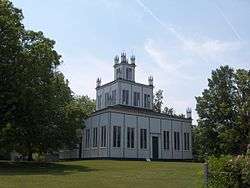
In Vaughan, the major attractions include the McMichael Canadian Art Collection, located in the community of Kleinburg and features works by Canadian artists including Inuit and First Nations artists. Canada's Wonderland, which features roller coasters and other rides, concerts and fireworks shows, is also in Vaughan.
Heritage sites and historical museums in the Region include:
- Hillary House National Historic Site (Aurora)
- Historic Main Street Newmarket (Newmarket)
- Georgina Military Museum (Georgina)
- Georgina Village Museum (Georgina)
- King Township Museum (King)
- Markham Museum (Markham)
- RHLS Narrow Gauge Railway (Whitchurch–Stouffville)[25]
- Sharon Temple National Historic Site (East Gwillimbury)
- Whitchurch-Stouffville Museum (Whitchurch–Stouffville)[26]
- York-Durham Heritage Railway (Whitchurch–Stouffville)[27]
Following is a sample of other attractions in the area:
- Applewood Farm Winery (Whitchurch–Stouffville)[28]
- Canadian Heritage Humber River
- Fred Varley Art Gallery (Markham)
- Canada's Wonderland (Vaughan)
- Oak Ridges Trail
- Puck's Farm (King)
- Richmond Hill Centre for the Performing Arts
- Sutton-Zephyr Trail
- Willow Springs Winery (Whitchurch–Stouffville)[29]
- Words Alive Literary Festival (East Gwillimbury)
- Bare Oaks Family Naturist Park (East Gwillimbury)
- York Demonstration Forest (Whitchurch–Stouffville)
Travel Region
York Region lies within the Central Counties of Ontario, a tourism related association.
Protected areas
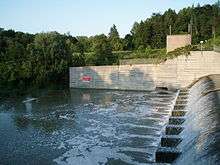
- Baker Sugarbush Conservation Area
- Boyd Conservation Area
- Bruce's Mill Conservation Area
- Duclos Point Provincial Nature Reserve
- Gold Creek Conservation Area
- Holland Landing Prairie Provincial Nature Reserve
- Kortright Centre for Conservation
- Lake St. George Conservation Area
- Mabel Davis Conservation Area
- Milne Park
- Pickering Lands Preservation Site
- Rogers Reservoir Conservation Area
- Sheppards Bush Conservation Area
- Sibbald Point Provincial Park
- Thornton Bales King Conservation Area
- Wesley Brooks Memorial Conservation Area (known as "Fairy Lake" locally[30])
- Whitchurch Conservation Area
- Willow Beach Conservation Area
Sister city
The Region of York signed a "Twinning Agreement" with the city of Omsk, Russia, on August 28, 1997, after it signed a "Friendship Agreement" one year previous.
Demographics
The Regional Municipality of York is one of the fastest growing census divisions in Canada; from 2001 to 2006, its population increased by 22.4%.[31] The 2009 mid-year population estimate by Statistics Canada was 1,016,379 residents.[32] It is the third-largest census division in Ontario, next to that of Toronto and Peel Region,[32] and seventh-largest in Canada.[33] Its population density of 585.9 residents per square kilometre is 11th highest in Canada.[33]
According to the Canada 2011 Census:[34]
- Population:
- in 2011: 1,032,524
- in 2006: 892,712
- change: +15.7%
- Land area (square km) 1,762.17
- Total private dwellings: 334,447
- Private dwellings occupied by usual residents: 323,543
According to the 2006 census visible minorities comprised 37.2% of the population of York Region.
- Visible Minority groups
- Chinese: 15.6%
- South Asian: 9.1%
- West Asian: 2.4%
- Black: 2.4%
- Filipino: 1.9%
- Korean: 1.2%
- South East Asian: 1.1%
- Latin American: 1.0%
- Arab: 0.8%
- Japanese: 0.2%
- Other: 0.4%
- Multiple Visible Minority: 1.0%
- European Ethnicities
- Other
Adjacent census divisions
See also
References
- "(Code 3519) Census Profile". 2011 census. Statistics Canada. 2012. Retrieved 2012-03-01.
Notes
- ↑ "Former Town of Whitchurch-Stouffville mayor Wayne Emmerson elected York Region Chairman and CEO" (Press release). The Regional Municipality of York. December 11, 2014. Retrieved 12 December 2014.
- 1 2 Statistics Canada: 2012
- ↑ http://www12.statcan.gc.ca/census-recensement/2016/dp-pd/prof/details/page.cfm?Lang=E&Geo1=CD&Code1=3519&Geo2=PR&Code2=35&Data=Count&SearchText=York&SearchType=Begins&SearchPR=01&B1=Population&TABID=3
- ↑ "York Region Official Plan — December 2009". Regional Municipality of York. 16 December 2009. Retrieved 2010-04-08.
- 1 2 3 4 5 6 Lott, John (13 May 1970). "Approval, relief first reactions of politicians". The Era. pp. 1, 2. Retrieved 30 April 2015.
- ↑ The Regional Municipality of York Act, 1970, S.O. 1970, c. 50
- 1 2 3 4 "highlights". The Era. 13 May 1970. p. 1. Retrieved 30 April 2015.
- ↑ 1970 Act, s. 2
- 1 2 3 4 5 6 7 Carter, Terry (13 May 1970). "Towns to win in regional land 'stakes". The Era. pp. 1, 17. Retrieved 30 April 2015.
- 1 2 "Amalgamation:E.G. yes, Newmarket no". The Era. 13 May 1970. p. 1, 2. Retrieved 30 April 2015.
- ↑ 1970 Act, s. 178
- ↑ The York Municipal Hydro-Electric Service Act, 1978, S.O. 1978, c. 31
- ↑ 1978 Act, s.2
- ↑ 1978 Act, s.3
- 1 2 3 1978 Act, s.4
- ↑ "York Region Interactive Map". The Region of York Community Services. Retrieved 27 July 2013.
- ↑ "Toronto Buttonville Airport". Canadian Climate Normals 1981−2010. Environment Canada. Retrieved 2014-04-12.
- ↑ "Richmond Hill, Ontario". 1981–2010 Canadian Climate Normals. Environment Canada. Retrieved 2015-02-16.
- ↑ "Stouffville WPCP". Canadian Climate Normals 1971–2000. Environment Canada. Retrieved 2016-05-12.
- ↑ "Woodbridge, Ontario". Canadian Climate Normals 1981–2010. Environment Canada. Retrieved 2013-12-17.
- ↑ "Council Members". The Regional Municipality of York. Retrieved 2006-10-26.
- ↑ "Reasons for Selection, 2009 Greater Toronto's Top Employers Competition".
- ↑ http://www.york.ca/Services/Water/Water+Supply/default_Water_Supply_New.htm
- ↑ http://www.newmarket.ca/en/townhall/resourcelibrary/2014WQSummaryReportFinal.pdf
- ↑ Richmond Hill Live Steamers. Richmond-hill-live-steamers.tripod.com. Retrieved on 2013-07-26.
- ↑ Town of Whitchurch Stouffville. Townofws.com. Retrieved on 2013-07-26.
- ↑ York-Durham Heritage Railway - "The Heritage Train" - Between Uxbridge and Stouffville. Ydhr.on.ca. Retrieved on 2013-07-26.
- ↑ Welcome To Applewood Farm Winery - Fruit Wines - Apple & Strawberry Picking. Applewoodfarmwinery.com (2013-07-14). Retrieved on 2013-07-26.
- ↑ Willow Springs Winery. Willow Springs Winery. Retrieved on 2013-07-26.
- ↑ Wesley Brooks Memorial :: Lake Simcoe Region Conservation Authority. Lsrca.on.ca. Retrieved on 2013-07-26.
- ↑ "York, Ontario (Regional municipality)". Canada 2006 Census. Statistics Canada. Retrieved 2010-04-04.
- 1 2 "Ontario census divisions — Annual population estimates at July 1". Annual Demographic Estimates. Statistics Canada. Retrieved 2010-04-04.
- 1 2 "Population and dwelling counts, for Canada and census divisions, 2011 and 2006 censuses". Canada 2006 Census. Statistics Canada. Retrieved 2015-04-25.
- ↑ "Population counts, for Canada, provinces and territories, census divisions by urban population size groups and rural, 2011 Census". Canada 2011 Census. Statistics Canada. Retrieved 2015-04-25.
External links
| Wikimedia Commons has media related to Regional Municipality of York. |

